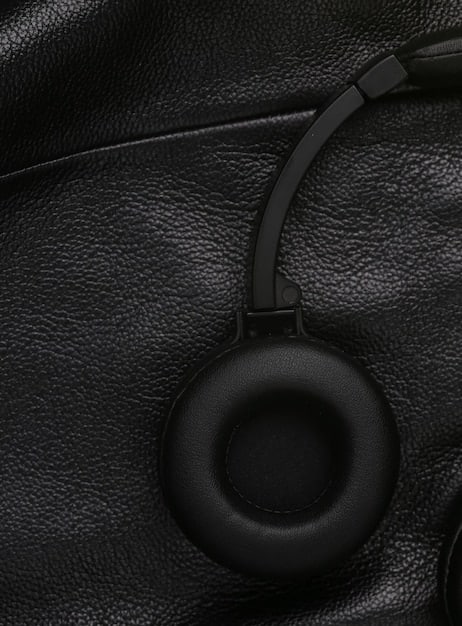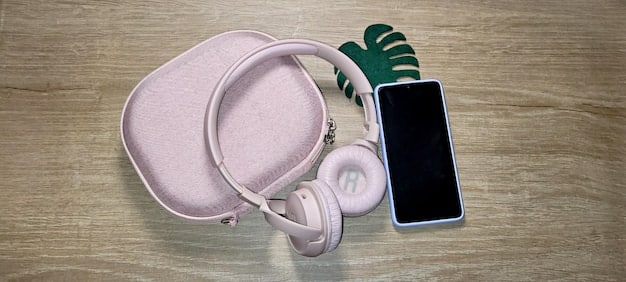Future Tech Trends Article – future_tec_kabumtechcom_10_1753818481_6f439306_are_the_ne.html

In 2025, the new generation of noise-canceling headphones, priced at around $350, offers enhanced adaptive noise cancellation, superior audio fidelity, and advanced integration with AI assistants, making them a worthwhile investment for discerning users seeking premium personal audio experiences.
In a world increasingly filled with auditory distractions, the promise of silence, or at least a personalized soundscape, becomes invaluable. This brings us to a pressing question for tech enthusiasts and casual listeners alike: Are the new noise-canceling headphones worth the $350 price tag? A 2025 review suggests the landscape of personal audio has evolved significantly, offering features that justify a premium investment for many.
the evolution of noise cancellation tech
The journey of noise-canceling technology has been a fascinating one, moving from bulky, specialized equipment to the sleek, indispensable devices we see today. In 2025, the leap in this technology isn’t just incremental; it’s transformative, offering a level of quietude and auditory immersion previously unimaginable. Early iterations of active noise cancellation (ANC) primarily focused on static, low-frequency sounds, often introducing a noticeable “hiss.” Modern advancements have largely eliminated these drawbacks.
Today’s top-tier headphones leverage complex algorithms and multiple microphones to create dynamic sound profiles that adapt to the user’s environment in real-time. This means whether you’re on a crowded subway, in a bustling cafe, or working remotely with ambient household noises, the headphones continuously adjust to provide optimal quietness without compromising audio quality. This adaptive capability is a key differentiator from models just a few years ago.
adaptive noise cancellation: A game changer
Adaptive ANC is perhaps the most significant functional improvement. Instead of a one-size-fits-all approach, these systems use AI and machine learning to analyze the incoming soundscape and generate precise anti-noise frequencies. This process happens almost instantaneously, creating a seamless bubble of tranquility around the listener. It’s a leap from simply reducing noise to intelligently nullifying it, allowing for greater focus and enjoyment.
- Real-time environmental analysis: Constantly monitors ambient sound.
- Dynamic frequency response: Adjusts noise cancellation based on sound type.
- Enhanced clarity for calls: Isolates voice from background noise.
- Reduced listener fatigue: Less strain from constant noise processing.
Beyond simple noise reduction, the technology also integrates transparency modes that are far more natural. Users can seamlessly switch between full immersion and awareness of their surroundings with a tap, often with the ability to customize which specific sounds are allowed through, such as human voices or public announcements. This level of control adds significant value, especially in urban environments where awareness is crucial.
The continuous refinement of this technology highlights a clear trend: personal audio is becoming increasingly personalized and intelligent. The ability of headphones to understand and react to their environment is a testament to the sophistication packed into these devices, making the $350 price point appear less daunting when considering the advanced engineering at play.

audio fidelity in the new era
While noise cancellation is a primary selling point, the core purpose of headphones remains delivering exceptional audio. In 2025, advancements in audio fidelity have kept pace with noise cancellation, ensuring that users aren’t just getting quiet but also getting a pristine listening experience. The $350 price tag often reflects not only cutting-edge ANC but also superior drivers, codecs, and digital signal processing (DSP) that elevate sound quality to new heights.
The latest headphones frequently support high-resolution audio codecs like LHDC or aptX Adaptive, offering lossless or near-lossless streaming over Bluetooth. This means that compared to older models relying on standard SBC or AAC codecs, users can experience a much richer, more detailed soundstage, closer to wired audiophile setups. This improvement is particularly noticeable with high-fidelity music streaming services that have become more prevalent.
spatial audio and personalized sound
Spatial audio has matured considerably, moving beyond a novelty to become a genuinely immersive feature. Many new headphones integrate advanced head-tracking technology, creating a dynamic sound environment where audio objects appear to be placed in a 3D space around the listener, rather than just emanating from left and right channels. This experience is particularly compelling for movies, games, and even certain music tracks designed for spatial audio.
- Enhanced immersion: Sound appears to come from all directions.
- Personalized HRTF profiles: Tailored audio based on individual ear anatomy.
- Dynamic head-tracking: Soundstage remains fixed relative to the device.
- Adaptive EQ: Adjusts sound profile automatically for different content.
Furthermore, personalization isn’t limited to noise cancellation. Many premium models now offer sophisticated sound customization options, often through companion apps. Users can create personalized EQ settings, even going as far as performing in-app hearing tests that generate a unique sound profile tailored to their specific auditory response. This level of fine-tuning ensures that the audio experience is optimized for individual preferences, making every song, podcast, or call sound exactly as desired.
The combination of high-resolution audio support, advanced spatial audio, and deep personalization options marks a significant leap in audio fidelity. These features demand more powerful processors and higher-quality components, which naturally contribute to the $350 price point. For audiophiles or those who simply appreciate superior sound, these advancements offer a compelling reason to invest.
smart features and connectivity in 2025
Beyond audio and noise cancellation, the premium segment of noise-canceling headphones in 2025 is defined by their “smart” capabilities and seamless connectivity. These devices are no longer just audio output tools; they are sophisticated extensions of our digital lives, deeply integrated with our smart ecosystems. The $350 price tag reflects this elevated level of functionality, moving beyond basic Bluetooth pairing.
Multi-point connectivity is now commonplace, allowing seamless switching between multiple devices (e.g., phone, laptop, tablet) without manual re-pairing. Bluetooth 5.3 and upcoming standards ensure ultra-low latency, greater range, and improved power efficiency, making the wireless experience virtually indistinguishable from wired connections for most users. This reliability is crucial for productive work environments and uninterrupted entertainment.
AI integration and voice control
The integration of AI assistants has reached new heights. In 2025, it’s not just about triggering Siri or Google Assistant; it’s about context-aware interactions. Headphones can now proactively offer information, manage notifications, and even translate conversations in real-time, leveraging on-device AI processing and cloud-based intelligence. This transforms them into truly intelligent personal assistants you wear on your head.
- Contextual AI suggestions: Proactive information based on location or activity.
- Enhanced voice assistant response: Faster and more accurate command recognition.
- Real-time language translation: On-the-fly translation in supported languages.
- Gesture and touch controls: Intuitive interactions beyond physical buttons.
Battery life has also seen significant improvements. Many premium models boast 30-40 hours of playback with ANC enabled, and rapid charging capabilities mean a few minutes on the charger can provide hours of listening. This increased endurance is vital for travel, long commutes, and extended work sessions, reducing the anxiety of a dead battery. The convenience of these smart features, from quick device switching to reliable voice commands, significantly adds to the overall value proposition of these headphones.
The sophisticated interplay of hardware and software, enabling these intelligent features and seamless connectivity, requires substantial research, development, and high-quality components. This engineering complexity contributes directly to the higher price point, offering a level of convenience and integration that defines the 2025 personal audio experience.
design, comfort, and build quality
At $350, consumers expect not just advanced technology but also a premium tactile experience. The design, comfort, and build quality of noise-canceling headphones in 2025 are paramount, often justifying a significant portion of their cost. Manufacturers are increasingly utilizing high-quality materials, ergonomic designs, and durable construction to ensure longevity and unparalleled comfort for extended wearing.
Materials like anodized aluminum, genuine leather, and high-density memory foam are common in this price bracket, providing a luxurious feel and robust build. These aren’t just aesthetic choices; they contribute to the acoustic performance, durability, and overall comfort of the device. The attention to detail in stitching, hinge mechanisms, and button tactile feedback sets these models apart from their mid-range counterparts.
ergonomics and portability
Comfort, especially for noise-canceling headphones often worn for hours, is non-negotiable. Modern designs prioritize balanced weight distribution, optimal clamping force, and breathable earcups to prevent discomfort and overheating. Many models feature swiveling earcups and collapsible designs, making them highly portable and easy to store in compact travel cases, which are typically included.
- Lightweight construction: Reduces neck strain during long wear.
- Breathable earcups: Prevents heat buildup and sweat.
- Adaptive headbands: Distributes weight evenly for varied head shapes.
- Durable folding mechanisms: Ensures longevity for portability.
The engineering involved in creating a comfortable yet secure fit, especially one that also optimizes noise isolation, is complex. Pressure points are carefully considered, and materials are selected to be both supple and resilient. This meticulous approach to human-centric design ensures that wearing these headphones isn’t just about escaping noise, but doing so in utmost comfort. Water and sweat resistance are also becoming more prevalent, catering to active lifestyles.
Ultimately, the premium materials and thoughtful design contribute significantly to the perceived value of these headphones. They are not merely gadgets but fashion accessories and tools for daily living, built to withstand regular use while maintaining a sophisticated aesthetic. This blend of form and function underlines the $350 investment.

the competitive landscape and value proposition
In 2025, the noise-canceling headphone market is highly competitive, featuring established giants and innovative newcomers. This intense competition often pushes manufacturers to deliver more value for the price, yet the $350 segment remains a premium tier. Understanding the value proposition requires looking beyond individual features to the holistic user experience offered.
While cheaper alternatives exist, they typically involve compromises in one or more areas: less effective ANC, inferior audio quality, fewer smart features, or a less premium build. The $350 price point often represents the sweet spot where technological innovation, material quality, and user experience converge without reaching the diminishing returns of ultra-high-end audiophile equipment.
are professional use cases justifying the cost?
For many, these headphones are no longer just for leisure. They are essential tools for remote work, content creation, and frequent travel. In these professional contexts, the investment quickly pays dividends. Uninterrupted focus during online meetings, crystal-clear call quality due to advanced microphone arrays, and fatigue reduction on long flights make these devices productivity enhancers rather than mere entertainment gadgets.
- Enhanced productivity: Minimizes distractions for focused work.
- Superior call quality: Crucial for virtual meetings and client calls.
- Travel essential: Reduces fatigue from airplane and train noise.
- Long-term reliability: Built to withstand daily professional use.
Consider the cost per use: if a $350 pair of headphones is used daily for two years, the cost is less than 50 cents a day. When weighed against the benefits of improved focus, enhanced relaxation, and a superior audio experience, this daily cost becomes negligible. Furthermore, strong brand reputations in this segment often come with excellent customer support and firmware updates that add new features over time, extending the lifespan and value of the product.
Ultimately, the $350 price point reflects a bundle of premium features, performance, and durability that caters to a demanding market. For users who prioritize a top-tier audio experience, effective noise cancellation, and seamless smart integration, the value offered by the latest generation of noise-canceling headphones in 2025 is substantial and often outweighs the initial outlay.
the future of personal audio: what to expect
Looking ahead, the trajectory for noise-canceling headphones in and beyond 2025 points to even greater sophistication and pervasive integration into our daily lives. The current generation, priced around $350, is a strong indicator of this path, showcasing the potential for deeply personalized, context-aware audio experiences. However, the innovation doesn’t stop here, suggesting sustained value from current investments and exciting prospects for future models.
Expect further miniaturization and increased energy efficiency, allowing for lighter devices with even longer battery lives. The physical form factor of headphones may also begin to diversify, with more emphasis on discrete in-ear solutions offering similar or superior noise cancellation capabilities as over-ear models, without sacrificing audio fidelity.
neural interfaces and health integration
The distant future may see more rudimentary neural interfaces, where headphones could monitor brain activity to adjust soundscapes based on cognitive load or stress levels, providing truly adaptive environments for focus or relaxation. Health monitoring capabilities, already present in some wearables, could become standard, offering insights into posture, heart rate, or even stress directly from the ear.
- Advanced bio-feedback: Headphones sensing user’s emotional or physical state.
- Hyper-personalized soundscapes: Adaptive audio for stress reduction or focus.
- Enhanced reality overlays: Blending digital audio seamlessly with physical sounds.
- Direct brain-computer interfaces: More intuitive control and interaction.
Moreover, the integration with augmented reality (AR) ecosystems will likely deepen. Our headphones could become primary auditory interfaces for AR experiences, providing spatial audio cues and voice interactions that blend seamlessly with visual overlays. This would transform them into essential components of a multi-sensory digital experience, rather than standalone audio devices.
The $350 headphones of 2025 are thus not just products of current innovation but a stepping stone towards a future where audio becomes an even more integral and intelligent part of our interaction with the world. Their sophistication today hints at the vast possibilities ahead, reinforcing their value as an investment in a cutting-edge, evolving technology.
| Key Feature | Brief Description |
|---|---|
| 🎧 Adaptive ANC | Real-time noise cancellation adjusting to your environment for ultimate quiet. |
| 🎶 Spatial Audio | Immersive 3D sound experience with dynamic head-tracking for movies & music. |
| 🧠 AI Integration | Context-aware voice assistants and real-time translation for smart interactions. |
| 🏗️ Premium Build | Durable, comfortable design with high-quality materials for long-term wear. |
Frequently Asked Questions About 2025 Noise-Canceling Headphones
▼
The primary difference lies in advanced adaptive noise cancellation (ANC), which intelligently adjusts to your environment. Older models were often static, while 2025 models use AI to dynamically cancel noise. Additionally, newer headphones offer superior audio fidelity, enhanced spatial audio, and deeper integration with smart assistants, providing a far more immersive and intelligent listening experience.
▼
Given the significant technological advancements in 2025, including real-time adaptive ANC, high-resolution audio support, sophisticated spatial sound, and robust AI integration, $350 is generally considered a reasonable price point. This cost reflects the extensive research and development, premium materials, and complex engineering required to deliver such a comprehensive and high-quality user experience.
▼
Audio fidelity in 2025 headphones has improved through support for higher-resolution audio codecs (e.g., LHDC, aptX Adaptive), offering nearly lossless wireless audio. Furthermore, advanced digital signal processing (DSP) and more accurate drivers contribute to a richer, more detailed soundstage. Spatial audio with dynamic head-tracking also provides a deeply immersive 3D sound experience not typically found in older or cheaper models.
▼
Absolutely. High-end noise-canceling headphones significantly enhance productivity for remote work by creating a silent environment, minimizing distractions from household noise or open-plan offices. Features like clear microphone arrays for calls, seamless multi-device connectivity, and long battery life contribute to uninterrupted focus and professional communication, making them an invaluable tool for many.
▼
When investing in $350 noise-canceling headphones, prioritize adaptive ANC effectiveness, high-resolution audio support, comfort for long wearing periods, and the level of smart features like AI integration and multi-point connectivity. Also, consider battery life, build quality, and companion app functionality for personalized sound settings and future firmware updates to ensure long-term satisfaction.
conclusion
In 2025, the landscape of personal audio has transformed, pushing noise-canceling headphones well beyond simple sound muffling. The $350 price tag, while a significant investment, reflects a suite of sophisticated features: truly adaptive noise cancellation that intelligently reacts to your surroundings, unparalleled audio fidelity driven by advanced codecs and spatial sound, and seamless integration with AI and smart ecosystems. These headphones are no longer just devices for listening but intricate tools designed to enhance productivity, immersive entertainment, and overall well-being by creating a personalized sanctuary of sound. For those who value silence, superior audio, and cutting-edge technology as an integral part of their daily routine, the latest generation of noise-canceling headphones undoubtedly offers compelling value, justifying the premium outlay for a truly transformative auditory experience.





